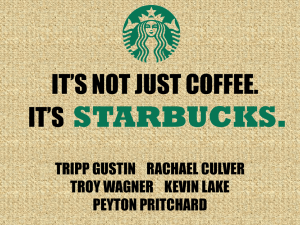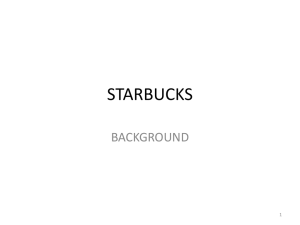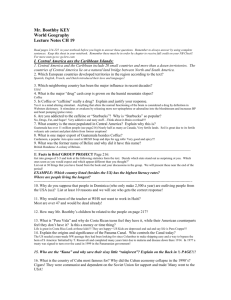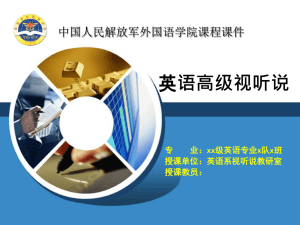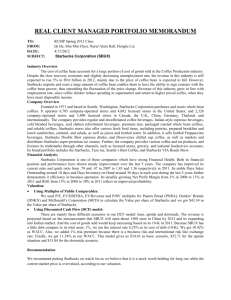Short profile of innovation in the corporate world Retail industry
advertisement
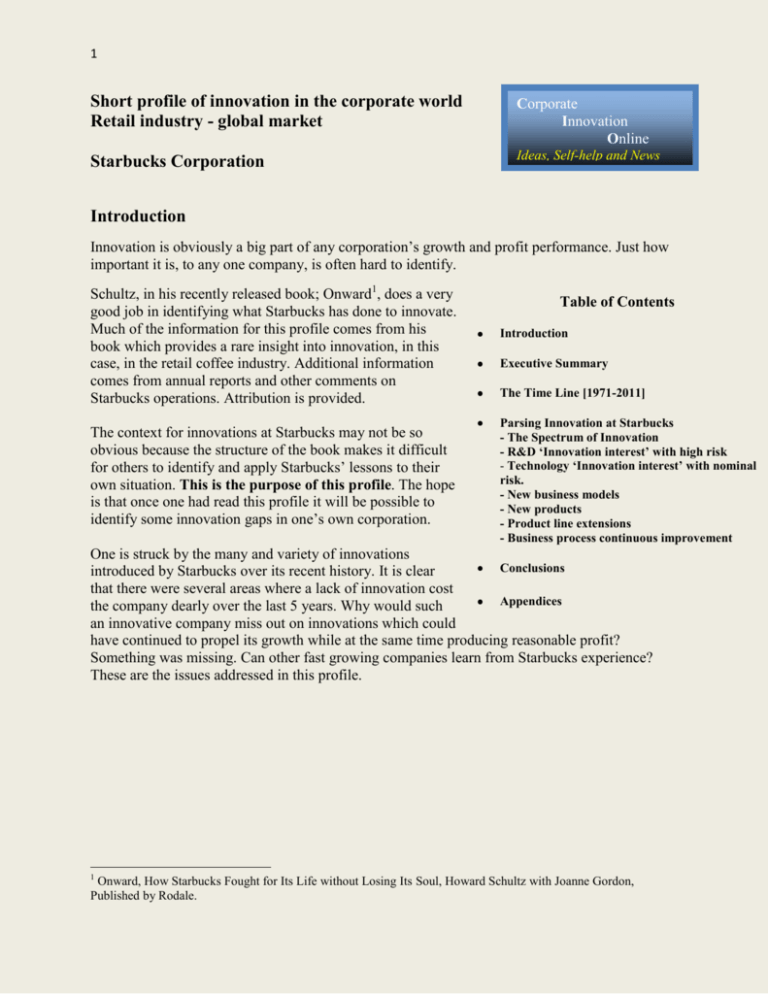
1 Short profile of innovation in the corporate world Retail industry - global market Corporate Innovation Online Starbucks Corporation Ideas, Self-help and News Introduction Innovation is obviously a big part of any corporation‟s growth and profit performance. Just how important it is, to any one company, is often hard to identify. Schultz, in his recently released book; Onward1, does a very good job in identifying what Starbucks has done to innovate. Much of the information for this profile comes from his book which provides a rare insight into innovation, in this case, in the retail coffee industry. Additional information comes from annual reports and other comments on Starbucks operations. Attribution is provided. The context for innovations at Starbucks may not be so obvious because the structure of the book makes it difficult for others to identify and apply Starbucks‟ lessons to their own situation. This is the purpose of this profile. The hope is that once one had read this profile it will be possible to identify some innovation gaps in one‟s own corporation. Table of Contents Introduction Executive Summary The Time Line [1971-2011] Parsing Innovation at Starbucks - The Spectrum of Innovation - R&D ‘Innovation interest’ with high risk - Technology ‘Innovation interest’ with nominal risk. - New business models - New products - Product line extensions - Business process continuous improvement One is struck by the many and variety of innovations Conclusions introduced by Starbucks over its recent history. It is clear that there were several areas where a lack of innovation cost Appendices the company dearly over the last 5 years. Why would such an innovative company miss out on innovations which could have continued to propel its growth while at the same time producing reasonable profit? Something was missing. Can other fast growing companies learn from Starbucks experience? These are the issues addressed in this profile. 1 Onward, How Starbucks Fought for Its Life without Losing Its Soul, Howard Schultz with Joanne Gordon, Published by Rodale. 2 Executive Summary This is what others can learn from the Starbucks experience with innovation. Innovation is not just about new product introductions or product line extensions. Innovation encompasses a range of associated logistical and sensory ideas and decisions. During growth spurts it is even more important to ensure that innovation occurs in operations areas such as cost reduction and quality improvement. Growth became Starbucks strategy not the tactic2; is Schultz‟s realization on his return as „ceo‟. An active Board of Directors can be expected to provide valuable input to the CEO, as in the case of Starbucks, but the advice for cost reduction is easier come by from the Board than are ideas for organic growth. Board members do not have, nor are they expected to have, an in-depth knowledge of technology nor a solid feel for the culture of the organization. “The more you know about the technology of the business, the more you can tweak”3. Starbuck’s deep knowledge about coffee is at the root their success. A heavy reliance on outsiders, both consultants and new hires, may well be necessary if internally-appointed personnel, i.e. those who have grown up with the company, do not have „other‟ experience and an outsider‟s perspective. Starbucks has relied heavily on outside hires in recent years and for the turn around. Schultz was only able to make this rapid turnaround [post 2007] because of his intimate knowledge of the business and the fact that he had continued on as Chairman and chief global strategist and had never really left the organization. Such rapid recoveries are unlikely to be realized by other companies, seeking salvation using outsiders. Up until the economic downturn in 2008 and the „failing‟ of Starbucks in late 2007, the company had a stellar record of innovations in most areas examined with the exception of innovations in business process and continuous improvement. This, in retrospect, was a major oversight. The emerging need to reduce costs and improve supply chain efficiencies was made more difficult since the topic of operations performance was relatively new to the enterprise. Outside hires were required. Starbucks demonstrates a very large number of innovative initiatives. In the last 2 to 3 years, the number of new initiatives, along with their attendant risk, is both impressive and at the same time concerning. While one never knows how an innovation will work out, it could be that Starbucks uses the market for its experiments rather than performing a full analysis 2 3 Onward, Tribute, p. 7. Onward, Chapter 10, p. 11 spoken by Andrew Linnemann – master blender. 3 ahead of time. Recent evidence4 suggests that emotion more than analysis may have been at work in launching new product initiatives. For example, Starbucks promotions were not always strategically synchronized5, suggesting there were almost too many innovative ideas being implemented at any one point in time! Sorbetto, after its launch, was cancelled after analysis pointed to high operating costs. The heavy emphasis on stock price and the need to satisfy Wall Street‟s need for quarterly results may have resulted from the subsidence of the stock price from previous highs and the sense that there was an obligation to restore „wealth on paper‟ to partners and shareholders. Over the longer term however, continued emphasis on quarterly results could reduce risk, constrain innovation and lessen the enhancement of shareholder value over the longer term. Innovation is the tool used by Starbucks to differentiate the company from all competitors6. There is no other retail coffee company let alone a retail company which has put so much effort into being innovative and making innovation part of its – as Schultz says – DNA. Schultz states that „candidly expressing his „business philosophies, feelings, and plans in writing to coworkers has been a habit of mine since 19867‟. As a consequence, the book is a rare insight into the thinking and leadership of a founder. 4 Bloomberg Businessweek, April 25 – Ma1, 2011, Michelle Gass is given credit for pulling the plug on Sorbetto because of her analytic approach, which if it had been undertaken at the time of evaluating the prospects for Sorbetto, would have resulted in its not entering the market. 5 Onward, Chapter 20, p. 2. 6 Onward, Chapter 3, p. 27. 7 Onward, Chapter 2, p. 2. 4 The Time Line [1971-2011] The Time Line in the book is not all that clear. Dates are provided for a number of seminal events but it is often difficult to discern the context; when the event took place in time and, more particularly, wheat else was going on at the same time. Centered mostly on Schultz‟s own actions, the focus of the book is on the period immediately after Schultz returned as „ceo‟. There are, however, many prior and later innovations which are noted since this profile focuses on Starbucks‟ innovation performance overall. Set out below is a reminder of the Time Line, as best it can be discerned from the book and other reference material. Only key events are portrayed. Constructing the Time Line provides the reader with an understanding of the intensity of innovation immediately after Schultz‟s return as „ceo‟. Such intensity could only have been accomplished by one who knew the company in-depth and over a long period. It is obvious that he never really left and, from his position of Chairman, had followed every nuance of Starbucks evolvement. 1971: the beginning at the Pike Place store. No change was to take place in the front interior and logo for another 11 years. The original company had established a reputation for high-quality, unique coffee8. Right from the beginning, the emphasis was on quality. 1982: September 7th; Shultz begins work at the first Starbucks store, Pike Place Market. This is where Schultz began „learning all about coffee‟9 as well as giving him a „customer orientation‟. One year later, on a trip to Italy, he discovers coffee‟s magic – the germination of an idea which was the beginning of the company. [How many others would have seen the same thing but not done anything about it!] 1986/87: He raised money from local investors in 1986 (April) and formed his own company; Il Giornale. He personally guaranteed the lease – somehow with no assets. He with Dave Olsen and Jennifer Ames-Karreman worked the counters – as baristas, thus providing them with hands-on experience which would prove to be invaluable as the company grew. Schultz was later - 1987 able to buy the original Starbucks business (consisting of 6 stores and a roasting plant) out from his former employers. Since he had no money, he raised $3.8 million from outside investors. The company added 6 stores to give a total of 11. 1992: Starbucks goes public. 8 9 Onward, Chapter 2, P. 9. Onward, Introduction, p. 2. 5 1993: Starbucks establishes an R&D facility10 under Don Valencia – and asked to build a worldclass team and create a water-soluble coffee. 1997: Uri Robinson joins the „tiny‟ R& D department. An extract (BBCB) became the base for Starbucks blended Frappuccino beverages and later two proprietary soluble powders used in a variety of products. 1999: First store in Beijing11. 2000: Schultz states that he had achieved a distinction; introducing the idea that it is not just what you drink but it is also the place where you drink - it is the social inter-connection that takes place which is important12. By this time he had been running the operation for 15 years and wanted new challenges. Orin C. Smith takes over as „ceo‟ – having been president and chief operating officer and previously CFO; joined in 1990. [He committed to staying five years and did so]. Schultz takes on the role of Chairman and chief global strategist. He is apart from the day-to-day running of the organization but in the same office he occupied during his time as „ceo‟13. Starbucks has 2,600 stores in 13 countries and revenue of almost $2 billion. 2001: Starbucks acquires Seattle‟s Best Coffee to add to its portfolio. 2003: Starbucks starts serving sandwiches (warm and breakfast and some containing cheese). Latterly, the introduction of sandwiches became viewed as a highly controversial move and symbolic of how Starbucks was losing its way. 2004: Starbucks starts sourcing coffee beans from Rwanda – 15 years after ethnic violence. Overall Starbucks sources coffee from 30 countries and thousands of farmers mostly operating small farms of only a few dozen acres14. 2005: R&D works to develop higher-quality but less-expensive soluble quality powders and methodologies for making soluble powders which could „stand on their own‟. Orin as „ceo‟ commits to social responsibility15. Under Orin‟s leadership, the store count tripled to 9,00016. Orin C. Smith leaves and is replaced. Jim Donald appointed „ceo‟ by the Board of Directors - the first outsider, ex. Wal-Mart, Safeway and Pathmark. Jim Donald remains until the summer of 2007. 2006: End; concern expressed by long-time partners over the emphasis on grow, grow, grow17. 2007: January - explaining why an instant coffee would take 32 more months to launch. Under pressure, and much earlier, the „code is cracked‟ for a Starbucks-quality coffee. February: Schultz writes his confidential (but leaked) memo – “The Commoditization of the Starbucks 10 Onward Chapter 27, p. 12 Onward, Chapter 33, p. 7. 12 Onward, Chapter 2, p. 13. 13 Onward, Chapter 2, p. 8. 14 Onward, Chapter 31, p. 2. 15 Onward, Chapter 3, p. 10. 16 Onward, Chapter, 3, p. 8. 17 Onward, Chapter 3, p. 20. 11 6 Experience” - to Jim Donald and the team. Summer: Schultz is out talking to „store, district, and regional managers directly, as well as baristas18. 2007: Starbucks begins to „fail itself‟19 - distracted from the „core of the business‟. Stock price drops 42 percent. The process of thinking about returning as „ceo‟ begins 6 months later. Starbucks coffee bested by McDonald‟s in a Consumer Report taste test. 2008: January; Schultz returns as „ceo‟ but to take „daily control‟20. The “Transformation Agenda Communication #1” was e-mailed January 7th. Pike Place Roast, a balanced but rich in flavor brew – designed to respond to consumer interest in a less than „bold‟ blend – is introduced. Pike Place Roast is referred to as a „reinvention of brewed coffee‟. Starbucks interest in the Clover leads to a buy out of this equipment manufacturer. 2008: A very busy innovative year. January; approves the roll out of the Verismo 801 – modified to Starbucks spec and called the Mastrena – a semi-automatic replacing the La Marzocco manual machine. By the end of 2008, 30% of the U.S. stores would have the Mastrena. February; Starbucks closes all of its 7,100 U.S. stores to „perfect our expresso‟21, to improve quality. March 4th was noted for the first ever meeting of 200 of the most senior leaders from around the world. First half – discovered the company which enabled the making and marketing of Sorbetto – i.e. a product not developed in the Starbucks research facility. April – Schultz announces that Starbucks will „bring more innovation to the market in the next 18 months than the company had brought in the past five years‟22. April end – Entertainment division is established – digital strategy, CD compilations and literature. June 30th - reference is made to the role of the Board in forcing the closing of 600 stores23 with the loss of 12,000 positions – 7% of the global work force. It was the Board24 which asked, in the fall of 2008, for the company to model what would happen if sales dipped negative 15% and to “Go deep”. July 29th – Realizing that the cost structure was unsustainable, Starbucks eliminates 1,000 non-store positions. The day is known as Black Tuesday. July – Schultz refers to „lack of cost-management‟25. Realization that Starbucks had missed the „technology revolution‟. Year end: the Mastrena machine provides a differentiated edge in the market place26. Decision made to once again grind beans in the store. 18 Onward, Chapter 5, p. 7. Onward, Introduction, p. 6. 20 Onward, Introduction, p. 8. 21 Onward, Chapter 1, p. 1 22 Onward, Chapter 17, p. 19 23 Onward, Chapter 19, p. 1 24 Onward, Chapter 25, p. 2. 25 Onward, Chapter 21, p. 8 26 Onward, Chapter 16, p. 9. 19 7 September: Starbucks is in freefall27 and the company emphasizes „cutting the fat out of Starbucks‟ operations - urgently. Realization that the supply chain was broken. October 26th, New Orleans is chosen for the site of the leadership conference - 10,000 people! About-to-happen system reforms were announced - remedying an outdated approach to corporate and in-store information systems. November: the need to take out $400 million in permanent costs is apparent. Board of Directors asks for Plan B, an even more aggressive reduction - just in case it is needed. Budget restructuring commences. Plan B was eventually implemented28. December: important analyst‟s conference in NY. 2009: Also a very busy innovative year. A concern about the „store experience‟ is noted. February, VIA – the instant coffee product is announced. April - Starbucks announces the new business unit; Digital Ventures; a digital network that serves a private channel for Starbucks customers. April – the epiphany of meeting Aldo Lorenzi and reading his book; That Shop in Via Montenapoleone – what it is to be a merchant is to tell a story by making sensory connections, emotional connections. June – signs of progress become evident29. A turning point is evident. Summer; Schultz wants to initiate a new in-store experience: interior design and customer service and partner engagement. July; introduction of „Street-name‟ stores – to run as independent businesses but linked to Starbucks in a variety of ways; mainly offering managers the right to try things which were not part of the Starbucks way. Third quarter; Starbucks has positive signs of recovery confirmed; above expectations. „Lean‟ is nominated as the most valued program for the year; late but better than never. December: appoints a head of global expansion. Schultz wants to further the business of Seattle‟s Best Coffee and appoints Gass to do the remake. 2010: January, Schultz asks for a „very special blend‟ to celebrate the company‟s 40th anniversary; a blend that would „resonate with our most loyal partners and customers‟. Different than Pike Place Roast, the Christmas Blend and the earlier „bold‟. June: building the leadership team adds heads of partner resources, global strategy, and corporate initiatives and planning. September: notes expansion in China and identifies this market as a second home market. December: Starbucks tells their story to an analyst‟s conference in New York. 2011: Seattle‟s Best Coffee continues to underperform with only 325 namesake cafes30 but with increasing market presence overall. Starbucks reaches 17,000 stores globally. 27 Onward, Chapter 22, p. 1 Onward, Chapter 30, p. 38. 29 Onward, Chapter 30, p. 37 30 Bloomberg Businessweek, April 25 – May 1, 2011. 28 8 Starbucks reports stellar results. See Appendices. With the Time Line in place, it is possible to closely examine the type and variety of innovation which marks Starbucks history. 9 Parsing Innovation at Starbucks Starbucks believes that innovation is in their DNA31. The company has introduced many innovations of all types over its history. Some innovations are more important than others. In an attempt to better understand the focus of Starbucks‟ innovation, this paper groups innovations under explicit topics. In so doing it is easier to identify areas of successful and not-so-successful innovation, as well as gaps in innovation performance. Others, but particularly retail operators, can learn much from the Starbucks experience. To be clear, Starbucks innovation record is outstanding. Successes and failures are the hallmark of this company. Risk has been assumed at each and every step, from the very beginning and since Schultz‟s return as „ceo‟. The Spectrum of Innovation Innovation is often hard to define. The word „innovation‟ has become common place and has a host of meanings. For the sake of discussion in this paper innovation embraces the exploration or adoption of new ideas from the most „fundamental research‟ through to „continuous improvement‟32. See The Spectrum of Innovation set out below. The Spectrum of Innovation From Fundamental Research to Continuous Improvement Industry/market/customer-centric 'Innovation interest' with minimal risk Business process continuous improvement Product line extensions Technology 'Innovation interest' with nominal risk 'Innovation interest' in common-use technologies to keep up to date. 'Innovation interest' in a defined market in order to differentiate product/service. New products New business models 'Innovation intererest' in emerging technologies. R&D 'Innovation interest' with high risk Applied Science/ Fundamental science "Innovation interest ' in research Decreasing risk. Innovation refers to the experimentation and adoption of new ideas of all kinds. Inherent in an idea is always the notion of change; grand or small, and the assumption of risk. Without risk, there is no innovation! 31 Onward, Chapter 27, p. 6. Programmed, and an almost unbroken, flow of improvements realized under a scheme such as Kaizan, lean production, or total quality management (TQM). A term credited to the Japanese, and brought into existence in the mid 1960s. 32 10 The term „innovation interest‟ is used to note that not all innovations are physical but can be emotional and may at times be simply thoughts which do not result, for many reasons, in actions or new products/services. This examination of Starbucks innovations is organized under the following topics. R&D „Innovation interest‟ with high risk. Technology „Innovation interest‟ with nominal risk. New business models. New products. Product line extensions. Business process continuous improvement The break out provides a comprehensive picture of the role which innovation has played in the growth and success of Starbucks. Roasting and processing coffee is at the heart of the technology of Starbucks business. There is both a science component and much art associated with the process of making an exceptional brew. The combination of the science and the art is the „know how‟ of the business and this is what Starbucks has brought to the market along with effective sourcing and a flair for retail marketing. Basic to the success of Starbucks is that it is, in the minds of millions of customers, a good tasting brew; and better than most! Schultz stresses the influence which Aldo Lorenzi, the Proprietor of „That Shop in Montenapolene, in Milan, Italy, had on his thinking. Lorenzi wanted to pass on to the younger generation, the idea of a „shop or workshop‟33 in order to „give root to an idea‟. The idea of tinkering, of exploring in-depth an idea, having a curious mind along with the desire to do something well, seems embedded in Lorenzi‟s short statement. This is the essence of innovation - without even using the word! R&D ‘Innovation interest’ with high risk Starbucks has not engaged in „Fundamental Science (see chart), but has engaged in „Applied Science‟ in a small but important area and this has laid the foundation for the business and the ability to engineer the product. The „know how‟ has facilitated the formulation of new products, their refinement, and contributed to Starbucks‟ reputation for quality. Two examples are noted. Research into the ability to have a high quality instant drink based on freeze-dry technology which had been earlier applied to blood testing procedures34. Roasting is accomplished with the use of roast curves; the result of extensive experimentation‟ both science and taste‟. 33 34 Onward, Opening Chapter. Onward, Chapter 27, p. 8. 11 Technology ‘Innovation interest’ with nominal risk There are four different forms of technology „innovation interest‟. 1.0 ‘Innovation interest’ in research Early on, as far back as 1982, Schultz began to learn „all about coffee‟. Starbucks set up an R&D facility in 1993, referred to as tiny, but probably unique initiative in the retail coffee business. More recently the Annual Report notes that Starbucks research and development teams are responsible for the technical development of food and beverage products and new equipment. The Company spent approximately $6.5 million, $7.2 million and $7.0 million during fiscal 2009, 2008 and 2007, respectively, on technical research and development activities. This is in addition to customary product testing and product/process improvements in all areas of its business. Starbucks demonstrates a long-term interest in R&D. 2.0 ‘Innovation interest’ in emerging technologies Starbucks had made the point that it wishes to be the „coffee authority‟, meaning that it needs to have, at all times, a definitive and deep knowledge – know how - of the complete supply chain for coffee. The company needs to be the best in the business. 3.0 ‘Innovation interest’ in a defined market in order to differentiate product/service Starbucks applies it‟s know how to provide product (and services) which clearly differentiates the company from its competitors. Examples include; Pike Place Roast, VIA, Bold and a wide variety of sweetened drinks. Other examples include; - R&D works to develop higher-quality but less-expensive soluble quality powders. Planning, research and testing had gone into the development of sandwiches – with a view of minimizing the „smell‟ by product. - The introduction of „ethically sourced coffee‟ differentiates Starbucks from many of its competitors. 4.0 ‘Innovation interest’ in common-use technologies to keep up to date Starbucks has demonstrated that it is quite capable of not only going beyond common-use technologies, but is able to keep up with the latest process technologies appearing on the market. Its acquisition of equipment supplier Clover is a case in point. Acquisition of the technology allowed the company to keep up to date and advance its product and service quality. Other examples include; - Starbucks has the best „combination of original technology and knowledge for procuring beans, roasting, blending and serving on a global scale35. - Starbucks builds on the „craft‟ involved in the growing of coffee. The passing down of knowledge from generation to generation is another form of keeping up to date on current technology. - No one in the industry has more control over the roasting process36. 35 36 Onward, Chapter 10, p. 6. Onward, Chapter 10, p. 7. 12 - - The „roast curve‟ is the match between time and heat applied to a range of blends of coffee bean. Trial and tasting is used to get the best result; science and art. In the Kent plant Starbucks uses 11 different roast curves to meet unique roast and flavour profiles. The Clover brewer equipment manufacturer is acquired but turns out to be best applied to exotic, smaller-batch Reserve coffees. The replacement of the La Marzocco manual machine with the semi-automatic Verismo 801 manufactured by a Swiss company; Thermo-Plan. New business models Starbucks has been at the forefront of introducing new business models to the retail coffee industry. Examples include. - The original Starbucks did not sell beverages, only whole-bean and ground coffee in bags for home consumption. - Starbucks moves to bring coffee to those outside the retail outlet channels; e.g. customers of Hyatt, Marriott, and in-stores such as Barnes and Noble, and Publix. - Introduction of „Street-named‟ stores obliquely connected to Starbucks; a concept which is just underway and its long-term results are not yet evident. Recent reports37 suggest the unit is underperforming. - Schultz combines (2000) two ideas into one product/service; it is not just what you drink but where you drink – a winning combination. - Closing down 7100 stores is a different business model; shutting down the whole operation even for a brief time, is significant in its action and perception and is here defined as a „business model‟. - Introducing rewards programs such as the Treat Receipt, the My Starbucks Rewards Card (2008), was significant for Starbucks but built on well established practices in other businesses. - The establishment of Digital Ventures is a new model, built around the strength of the brand. - VIA, because of its basic technology, allows for the establishment of a variety of new business models which are not dependent on the „store‟ or an apparatus to prepare a brew. New products Starbucks has introduced a large number of new products and service components, only a few of the more significant of which are mentioned here. - 37 Pike Place Roast - could be considered a product extension but, because of its significance being the first in a line of many new drinks - is considered a new product because of the risk attendant with a new product introduction. Sorbetto, thought to be a potentially successful product but based on research conducted by an Italian company – launched in July 2008. Sorbetto came in with a flurry and then was Bloomberg Businessweek, April 25 – May 1, 2011. 13 - allowed to fade away38. The plug is pulled after it was discovered that there were high shipping costs and baristas took a lot of time to clean up39. Mazagran – a new product but failed. Frappuccino – a new product and highly successful – accounted for $2 billion in sales in 2009. VIA, as an instant coffee developed because of R&D effort, opens up a host of new markets and channels. The Tribute Blend developed for the company‟s 40th anniversary, has attendant risk in the choice of beans as well as the concept itself. A test of newly formulated „limited edition reserve‟ products akin to the marketing of wine. The breakfast or warm sandwich introduced in 2003 – to much comment. Months of planning and research for this launch went into this product but nothing would satisfy Schultz as he emphasised the need to retain, in store, a coffee „aroma‟. He had wanted to stop this product in 2007, and finally got around to doing so when he assumed the role of „ceo‟40. Breakfast sandwiches are returned to the stores in June, 200841 after having all their recipes updated. Product line extensions The building of new store locations or the re-introduction of products, albeit with minor modifications are examples of product extensions. Starbucks considerable growth was dependent upon getting the formula right and then repeating it hundreds of times. - Sandwich recipes redone during 2008 and reintroduced to stores in June 2008. First store in Beijing established in 1999 is an extension of the model developed in North America. Expansion of the retail store network globally. Limited-release Starbucks Reserve coffees is an extension of the already-in-place high quality coffees. Redefining coffee blends such as French Roast or Verona to naming products; Level One (Mild, tight, crisp) or Level Five (Bold, dark, intense), for example. Business process continuous improvement Continuous improvement and „lean‟ services, took a back seat to other forms of innovation until the need for large-scale cost-reduction loomed in 2008. Growth had been the object right up to 2008 and the number of store opening per day was astounding. In the passion for growth, the issues of cost-reduction, supply-chain discipline, and supporting information technology had either not been recognized or put to one side. - Missed the technology revolution in terms of the adoption of advanced information systems and in-store management systems. 38 Schultz comment. Bloomberg Businessweek; April 25 – May 1, 2011. 40 Onward, Chapter11, p. 3. 41 Onward, Chapter 26, p. 17. 39 14 - - Supply chain had not matured with the growth of the company. Lack of discipline (relatively undisciplined) in back end infrastructure and operations. The introduction of the Mastrena machine, now in almost 70% of U.S. –owned stores, is representative of improvements of to the process of production but it also contributed to a product line extension. Its main contribution is to provide control to the baristas; the front line of Starbucks. Decision to bring back the grinding of coffee beans at the store level. Business process reengineering, continuous improvement, and cost reduction, as terms, all have somewhat of a negative overtone. There is a suggestion that criticism might not have been so easy to deliver to Schultz. Delivering bad news to a highly placed senior executive in some ways defines an organization. Michelle Gass is given credit for being „unafraid to deliver bad news‟ during meetings with Schultz, strongly suggesting that Schultz did not take kindly to receiving bad news42. For some, innovation has often meant only new products or new business models, and not internal and not-so-exciting business process improvements. Conclusions Starbucks, under Schultz, has accomplished much; a return of shareholder value, a lifting of the morale in the organization, a strengthening of the brand and its association with innovation, and a reputation for quality which is the envy of all. Starbucks strength is rooted in their complete understanding of coffee; the bean, the process, the brew, and the sale of product. Unlike a number of other companies, little has been outsourced so know how is embedded in the organization. With the recent updates in operations, supply-chain management, and IT sophistication, Starbucks has now covered the full spectrum of innovation. But a word of caution is raised by Nancy Koehn43: I'm not so sure, for what that's worth. It strikes me as dangerous when a company tries to diversify too far from its core business into a white space (delivering experiences or branded products). It also strikes me as misguided to try to "genericise" the Starbucks logo for the benefit of Chinese consumers when Chinese consumers are desperate to learn English (i.e. American) and behave like American consumers: the tagline is not a limiting factor but part of the brand's core appeal. Innovation runs strong in Starbucks but its greatest strength lies in the company‟s knowledge of the coffee bean and its complexities. Paul White, http://www.corporateinnovationonline.com, May 12th, 2011. 42 Bloomberg Businessweek, April 25 – May 1, 2011; Marketing, Starbucks Kid Brother Grows Up Fast. th Harvard Business School; Nancy Koehn is a leading expert on Starbucks. The Economist, January 13 , 2011. Schumpeter. 43 15 Appendices A Brief Profile of Starbucks Corporation44 Stock Performance Business Summary Starbucks Corporation purchases and roasts whole bean coffees. It operates approximately 16,858 stores, including 8,833 company-operated stores and 8,025 licensed stores. The company offers approximately 30 blends and single-origin premium arabica coffees. It also provides handcrafted beverages, such as fresh-brewed coffee, hot and iced espresso beverages, coffee and non-coffee blended beverages, Vivanno smoothies, and Tazo teas; and merchandise products, including home espresso machines, coffee brewers and grinders, coffee mugs and accessories, packaged goods, music, books, and gift items. In addition, it offers fresh food items, which comprise baked pastries, sandwiches, salads, oatmeal, yogurt parfaits, and fruit cups. Further, it also provides VIA ready brew coffee, bottled frappuccino beverages, discoveries chilled cup coffee, doubleshot espresso drinks, iced coffee, whole bean coffee, and ice creams. The company’s brand portfolio includes Tazo tea, Ethos water, Seattle’s Best Coffee, and Torrefazione Italia Coffee. Starbucks Corporation sells its products in approximately 50 countries worldwide. Starbucks Corporation was founded in 1971 and is based in Seattle, Washington. 44 Yahoo Finance 16 2009 Annual report, Starbucks Corporation Properties used by Starbucks in connection with its roasting and distribution operations: Location, Approximate Size in Square Feet, Owned or Leased Purpose Kent, WA . . . . . . . . . . . . . . . . . . . . . . . 332,000 Owned Roasting and distribution Kent, WA . . . . . . . . . . . . . . . . . . . . . . . 215,000 Leased Warehouse Renton, WA . . . . . . . . . . . . . . . . . . . . . 125,000 Leased Warehouse York County, PA . . . . . . . . . . . . . . . . . . 450,000 Owned Roasting and distribution York County, PA . . . . . . . . . . . . . . . . . . 298,000 Owned Warehouse York County, PA . . . . . . . . . . . . . . . . . . 118,000 Leased Warehouse Carson Valley, NV. . . . . . . . . . . . . . . . . 360,000 Owned Roasting and distribution Sandy Run, SC . . . . . . . . . . . . . . . . . . . 117,000 Owned Roasting and distribution Portland, OR . . . . . . . . . . . . . . . . . . . . . 68,000 Leased Warehouse Basildon, United Kingdom . . . . . . . . . . . 142,000 Leased Warehouse and distribution Amsterdam, Netherlands . . . . . . . . . . . . 97,000 Leased Roasting and distribution Employees The Company employed approximately 142,000 people worldwide as of September 27, 2009. In the US, Starbucks employed approximately 111,000 people, with 105,000 in Company-operated retail stores and the remainder in the Company‟s administrative and regional offices, and store development, roasting and warehousing operations. Approximately 31,000 employees were employed outside of the US, with 30,000 in Companyoperated retail stores and the remainder in the Company‟s regional support facilities and roasting and warehousing operations. The number of the Company‟s employees represented by unions is not significant. Starbucks believes its current relations with its employees are good. Research and Development Starbucks research and development teams are responsible for the technical development of food and beverage products and new equipment. The Company spent approximately $6.5 million, $7.2 million and $7.0 million during fiscal 2009, 2008 and 2007, respectively, on technical research and development activities, in addition to customary product testing and product and process improvements in all areas of its business. 17 Starbucks Reports Record Second Quarter 2011 Results Q2 EPS Up 21% to $0.34 Strong Traffic Drives 7% Increase in Global Comparable Store Sales Significant Increase in U.S. and International Operating Margins 40th Anniversary Tribute Contributes to Global Momentum SEATTLE, Apr 27, 2011 (BUSINESS WIRE) -- Starbucks Corporation (NASDAQ: SBUX) today reported financial results for its fiscal second quarter ended April 3, 2011. Fiscal Second Quarter 2011 Highlights: Total net revenues increased 10% to $2.8 billion Comparable store sales increased 7%, driven by a 6% increase in traffic and a 1% increase in average ticket o U.S. comparable store sales increased 7%, driven by a 6% increase in traffic and a 1% increase in average ticket o International comparable store sales increased 4%, driven by an increase in traffic Consolidated operating margin was 13.5%: up 10 basis points on a GAAP basis and down 20 basis points over the prior-year period's non-GAAP results o U.S. operating margin improved to 18.5%: up 70 basis points on a GAAP basis and up 60 basis points over the prior-year period's non-GAAP results o International operating margin improved to 11.8%: up 420 basis points on a GAAP basis and up 290 basis points over the prior-year period's non-GAAP results EPS increased 21% to $0.34 in Q2 FY11 compared to $0.28 in Q2 FY10 On March 1, Starbucks assumed direct management of its packaged coffee business On March 10, the company announced a strategic relationship with Green Mountain Coffee Roasters for the manufacturing, marketing, distribution and sale of Starbucks(R) coffee and Tazo(R) tea branded K-Cup(R) portion packs for use in the Keurig(R) Single-Cup Brewing system, making Starbucks the exclusive, licensed super-premium brand on the Keurig(R) platform The Board of Directors declared a $0.13 per share cash dividend to shareholders of record as of May 11, 2011, which will be paid on May 27, 2011 "Starbucks record fiscal second quarter results reflect solid performance and execution across all of our businesses," said Howard Schultz, chairman, president and ceo. "Our sales, traffic and customer trends all point to the expanding power of the Starbucks business and brand. And our 40th anniversary celebration continues to resonate around the world, driving strong engagement among our partners and our customers. I saw this firsthand in China, where my visit this week confirmed how ideally-positioned Starbucks is to profitably grow its store presence across China in the years ahead," added Schultz. "The underlying health of our business has never been better and our fiscal second quarter results continue to demonstrate this strength," commented Troy Alstead, cfo. "Customer traffic grew in both our U.S. and International segments and we continue to see improved profitability throughout the retail store business as operational improvements combined with revenue growth drive strong sales leverage. Our results for the quarter were even more significant when viewed in the context of the investments we made during the period and the charges related to Seattle's Best Coffee store closures in Borders bookstores," added Alstead. "We remain well positioned to deliver on our previously communicated fiscal 2011 outlook of 15% to 20% EPS growth compared to last year's results despite dramatically higher commodity costs."


